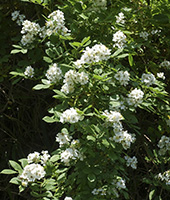News Release
- No.12940(2017/7/3)
-

Rosa multiflora Japanese Wild Rose Genome Sequenced
Collaboration with Kazusa DNA Research Institute and Nagoya
Suntory Global Innovation Center Limited has successfully sequenced the genome of the Japanese wild rose Rosa multiflora. The achievement came from a collaboration with the Kazusa DNA Research Institute and Nagoya University. The results will be presented at the VII International Symposium on Rose Research and Cultivation in France on Tuesday, July 4 (local time).
[Research Background]
The rose (the cultivated rose, Rosa × hybrida) was bred by extensive hybridization between about eight wild rose species. Rosa multiflora is famous as one of those wild roses. It is indigenous to East Asia, including Japan, and appeared? in the Man’yoshu, an ancient Japanese poetry collection. Records of rose cultivation and breeding indicate that Rosa multiflora was brought from Japan to Europe in the 1860s and used for breeding cultivated roses, giving them the property of clusteringflowers on one branch and resistance to disease.
Genome analysis of cultivated roses and their wild rose ancestors has been proceeding in various places throughout the world, but these projects have not yet reported enough results for a research paper.
This genomic acalysis of Rosa multiflora came from a collaborative research by Suntory Global Innovation Center, the Kazusa DNA Research Institute and Nagoya University.
[Research Summary]
The study analyzed the genome of Rosa multiflora, which is estimated to have approximately 710 million base pairs. From 67,380 candidate genes, the study identified horticulturally important genes that regulating flower color, scent, floral organ morphogenesis, perpetuity, and flower opening.
After the publication of the paper on this study, the “Rosa multiflora Genome Database” will be open to the public.
[Future Outlook]
This is the world’s first success determining the genome of a wild rose that contributed to the genome composition of cultivated roses. It is expected that further functional analysis of the genomegenetic functional analysis and comparison with the genomes of other roses will pave the way for revolutionary improvements in rose breeding that improve properties such as flower color, scent, and flowering.
It may also help further development of the flower color of the blue rose, of which the Suntory Group developed the world’s first.
Suntory Group’s Genome Mapping Projects
The Suntory Group has been the first in the world to sequence the genomes of other plants before, namely the carnation and the hop.

